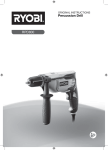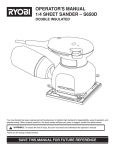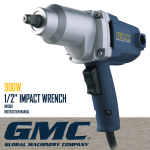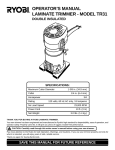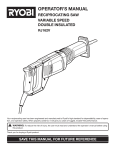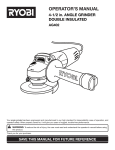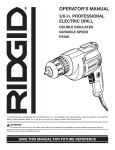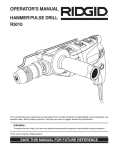Download Ryobi ROS300A
Transcript
ORIGINAL INSTRUCTIONS Random Orbital Sander ROS300 Important! It is essential that you read the instructions in this manual before operating this machine. Subject to technical modifications. Safety GENERAL POWER TOOL SAFETY WARNINGS serious personal injury. ■ Use personal protective equipment. Always wear eye protection. Protective equipment such as dust mask, non-skid safety shoes, hard hat, or hearing protection used for appropriate conditions will reduce personal injuries. ■ Prevent unintentional starting. Ensure the switch is in the off-position before connecting to power source and/or battery pack, picking up or carrying the tool. Carrying power tools with your finger on the switch or energising power tools that have the switch on invites accidents. ■ Remove any adjusting key or wrench before turning the power tool on. A wrench or a key left attached to a rotating part of the power tool may result in personal injury. ■ Do not overreach. Keep proper footing and balance at all times. This enables better control of the power tool in unexpected situations. ■ Dress properly. Do not wear loose clothing or jewellery. Keep your hair, clothing and gloves away from moving parts. Loose clothes, jewellery or long hair can be caught in moving parts. ■ If devices are provided for the connection of dust extraction and collection facilities, ensure these are connected and properly used. Use of dust collection can reduce dust-related hazards. WARNING Read all safety warnings and all instructions. Failure to follow the warnings and instructions may result in electric shock, fire and/or serious injury. Save all warnings and instructions for future reference. The term “power tool’’ in the warnings refers to your mains-operated (corded) power tool or battery-operated (cordless) power tool. WORK AREA SAFETY ■ Keep work area clean and well lit. Cluttered or dark areas invite accidents. ■ Do not operate power tools in explosive atmospheres, such as in the presence of flammable liquids, gases, or dust. Power tools create sparks which may ignite the dust or fumes. ■ Keep children and bystanders away while operating a power tool. Distractions can cause you to lose control. ELECTRICAL SAFETY ■ ■ ■ Power tool plugs must match the outlet. Never modify the plug in any way. Do not use any adaptor plugs with earthed (grounded) power tools. Unmodified plugs and matching outlets will reduce risk of electric shock. Avoid body contact with earthed or grounded surfaces such as pipes, radiators, ranges and refrigerators. There is an increased risk of electric shock if your body is earthed or grounded. Do not expose power tools to rain or wet conditions. Water entering a power tool will increase the risk of electric shock. ■ Do not abuse the cord. Never use the cord for carrying, pulling or unplugging the power tool. Keep cord away from heat, oil, sharp edges or moving parts. Damaged or entangled cords increase the risk of electric shock. ■ When operating a power tool outdoors, use an extension cord suitable for outdoor use. Use of a cord suitable for outdoor use reduces the risk of electric shock. ■ If operating power tools in a damp location is unavoidable, use a residual current device (RCD) protected supply. Use of an RCD reduces the risk of electric shock. PERSONAL SAFETY ■ Stay alert, watch what you are doing and use common sense when operating a power tool. Do not use a power tool while you are tired or under the influence of drugs, alcohol or medication. A moment of inattention while operating power tools may result in POWER TOOL USE AND CARE ■ Do not force the power tool. Use the correct power tool for your application. The correct power tool will do the job better and safer at the rate for which it was designed. ■ Do not use the power tool if the switch does not turn it on and off. Any power tool that can not be controlled with the switch is dangerous and must be repaired. ■ Disconnect the plug from the power source and/or the battery pack from the power tool before making any adjustments, changing accessories, or storing power tools. Such preventive safety measures reduce the risk of starting the power tool accidentally. ■ Store idle power tools out of the reach of children and do not allow persons unfamiliar with the power tool or these instructions to operate the power tool. Power tools are dangerous in the hands of untrained users. ■ Maintain power tools. Check for misalignment or binding of moving parts, breakage of parts and any other condition that may affect the power tools operation. If damaged, have the power tool repaired before use. Many accidents are caused by poorly maintained power tools. ■ Keep cutting tools sharp and clean. Properly maintained cutting tools with sharp cutting edges are less likely to bind and are easier to control. ■ Use the power tool, accessories and tool bits etc., in accordance with these instructions and in the 1 Safety manner intended for the particular type of power tool, taking into account the working conditions and the work to be performed. Use of the power tool for operations different from intended could result in a hazardous situation. WARNING When servicing use only identical Ryobi replacement parts. Use of any other parts may create a hazard or cause product damage. SERVICE ■ Have your power tool serviced by a qualified repair person using only identical replacement parts. This will ensure that the safety of the power tool is maintained. GENERAL Avoid using solvents when cleaning plastic parts. Most plastics are susceptible to various types of commercial solvents and may be damaged by their use. Use clean cloths to remove dirt, carbon dust, etc. SPECIAL SAFETY RULES ■ This product is not intended for use by persons (including children) with reduced physical, sensory or mental capabilities, or lack of experience and knowledge, unless they have been given supervision or instruction concerning use of the product by a person responsible for their safety. Children should be supervised to ensure that they do not play with the product. ■ Keep children and visitors away. Visitors should wear safety glasses and be kept as a safe distance from work area. Do not let visitors contact tool or extension cord. ■ It is recommended that this tool always be supplied via a residual current device with a rated residual current of 30mA or less. ■ Complies with AS/NZS 60745. ■ Always wear safety goggles and a dust mask when sanding, especially sanding overhead. ■ A suitable breathing respirator must be worn while sanding lead paint, some woods and metal to avoid breathing the harmful/toxic dust or air. WARNING Do not at any time let brake fluids, gasoline, petroleumbased products, penetrating oils, etc. come in contact with plastic parts. They contain chemicals that can damage, weaken or destroy plastic. Electric tools used on fiberglass material, wallboard, spackling compounds, or plaster are subject to accelerated wear and possible premature failure because the fiberglass chips and grindings are highly abrasive to bearings, brushes, commutators, etc. Consequently, we do not recommended using this tool for extended work on these types of materials. However, if you do work with any of these materials, it is extremely important to clean the tool using compressed air. WARNING Always wear safety goggles or safety glasses with side shields during power tool operation or when blowing dust. If operation is dusty, also wear a dust mask. LUBRICATION INTENDED USE You may use this product for the purposes listed below: ■ Sanding on wood surfaces. ■ Removing rust from and sanding steel surfaces. ■ Sanding plastics. All of the bearings in this tool are lubricated with a sufficient amount of high grade lubricant for the life of the unit under normal operating conditions. Therefore, no further lubrication is required. WARNING MAINTENANCE WARNING The tool should never be connected to a power supply when you are assembling parts, making adjustments, cleaning, performing maintenance, or when the tool is not in use. Disconnecting the tool will prevent accidental starting that could cause serious injury. 2 Always remove sanding sheet from sander before cleaning. Failure to do so could cause serious personal injury. ENVIRONMENTAL PROTECTION Recycle raw materials instead of disposing of as waste. The machine, accessories and packaging should be sorted for environmental-friendly recycling. Safety SYMBOL Unplug Safety Alert V Volts Hz Hertz Plug in Alternating current W Watts no No-load speed min־¹ Wear safety hand gloves Revolutions or reciprocations per minute Conformity Pad size Orbital diameter Double insulation Please read the instructions carefully before starting the product. Wear ear protection Wear eye protection Waste electrical products should not be disposed of with household waste. Please recycle where facilities exist. Check with your Local Authority or retailer for recycling advice. ICONS IN THIS MANUAL Safety Unpacking Getting started Information 3 Getting started 1 4 2 Getting started 3 4 1 6 1 2 5 Maintenance 1 2 3 4 3 6 PRODUCT SPECIFICATIONS Model ROS300 Rating 300 W Voltage 240 V No-load speed 7000 min־¹ - 13000 min־¹ Orbital stroke rate 14000 - 26000 opm Orbital diameter 2.4 mm Pad size 125 mm Weight 1.7 kg Cord length 3m 50Hz












